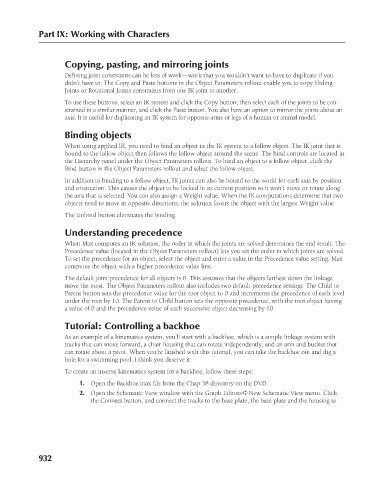Page 980 - Kitab3DsMax
P. 980
Part IX: Working with Characters
Copying, pasting, and mirroring joints
Defining joint constraints can be lots of work—work that you wouldn’t want to have to duplicate if you
didn’t have to. The Copy and Paste buttons in the Object Parameters rollout enable you to copy Sliding
Joints or Rotational Joints constraints from one IK joint to another.
To use these buttons, select an IK system and click the Copy button; then select each of the joints to be con-
strained in a similar manner, and click the Paste button. You also have an option to mirror the joints about an
axis. It is useful for duplicating an IK system for opposite arms or legs of a human or animal model.
Binding objects
When using applied IK, you need to bind an object in the IK system to a follow object. The IK joint that is
bound to the follow object then follows the follow object around the scene. The bind controls are located in
the Hierarchy panel under the Object Parameters rollout. To bind an object to a follow object, click the
Bind button in the Object Parameters rollout and select the follow object.
In addition to binding to a follow object, IK joints can also be bound to the world for each axis by position
and orientation. This causes the object to be locked in its current position so it won’t move or rotate along
the axis that is selected. You can also assign a Weight value. When the IK computations determine that two
objects need to move in opposite directions, the solution favors the object with the largest Weight value.
The Unbind button eliminates the binding.
Understanding precedence
When Max computes an IK solution, the order in which the joints are solved determines the end result. The
Precedence value (located in the Object Parameters rollout) lets you set the order in which joints are solved.
To set the precedence for an object, select the object and enter a value in the Precedence value setting. Max
computes the object with a higher precedence value first.
The default joint precedence for all objects is 0. This assumes that the objects farthest down the linkage
move the most. The Object Parameters rollout also includes two default precedence settings. The Child to
Parent button sets the precedence value for the root object to 0 and increments the precedence of each level
under the root by 10. The Parent to Child button sets the opposite precedence, with the root object having
a value of 0 and the precedence value of each successive object decreasing by 10.
Tutorial: Controlling a backhoe
As an example of a kinematics system, you’ll start with a backhoe, which is a simple linkage system with
tracks that can move forward, a chair housing that can rotate independently, and an arm and bucket that
can rotate about a pivot. When you’re finished with this tutorial, you can take the backhoe out and dig a
hole for a swimming pool. I think you deserve it.
To create an inverse kinematics system for a backhoe, follow these steps:
1. Open the Backhoe.max file from the Chap 38 directory on the DVD.
2. Open the Schematic View window with the Graph Editors ➪ New Schematic View menu. Click
the Connect button, and connect the tracks to the base plate, the base plate and the housing to
932

